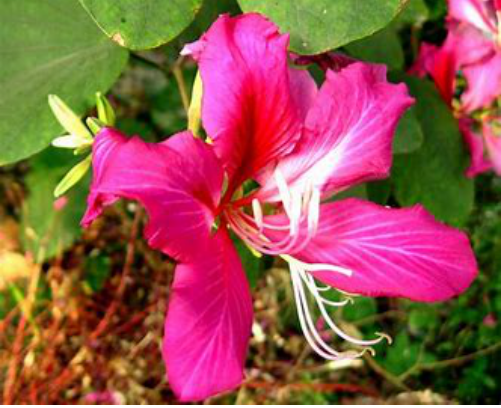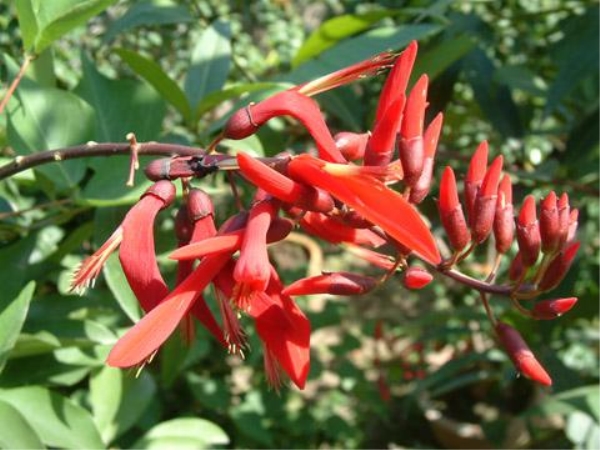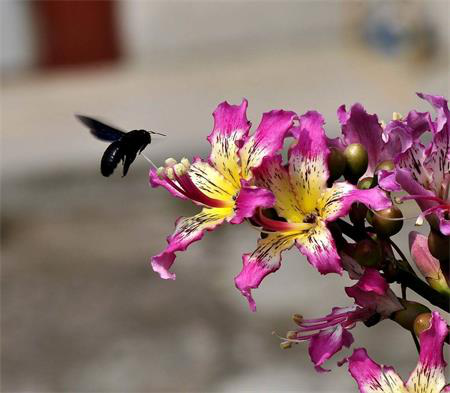Matters needing attention in daily maintenance of Bauhinia
1. Soil
Loose acid sandy soil with good drainage can be fertile and barren because it is resistant to barren. When transplanting Bauhinia, it is appropriate to bring some soil to the root of Bauhinia, which can improve the survival rate of transplantation.
Second, light and temperature
Bauhinia prefers a sunny and warm environment because it is not very hardy. However, Bauhinia has a certain negative tolerance, when the summer sun is hot and spicy, shade is needed to prevent exposure. The suitable temperature for the growth of Bauhinia chinensis is between 23 ℃ and 34 ℃. In winter, the temperature should be above 5 ℃. When the temperature is too low, the potted plants should be placed in the greenhouse to resist the cold.

III. Watering and fertilization
Bauhinia likes a humid environment, but avoid stagnant water. Keep sufficient water in spring and autumn, watering frequency is higher to maintain a certain humidity, pot planting in autumn and winter should be drier and reduce watering frequency. Watering in winter should be at noon. Fertilization methods are closely related to plant growth. In general, liquid fertilizer is applied 1-2 times in the growing period, and rarefied fertilizer and water is applied several times after flowering. In autumn, some phosphate fertilizer can be applied to promote flowering in the coming year.
Before waiting for the flowers to blossom in the coming year, let's take a closer look at the daily maintenance of Bauhinia.
Diseases and insect pests of Bauhinia chinensis and its control measures
Diseases of Bauhinia chinensis
There are two main diseases of Bauhinia, one is angular spot, the other is soot.
When Bauhinia is infected with angular spot, some polygonal disease spots will appear on the leaves of Bauhinia. In the later stage, the leaves of Bauhinia will gradually wither and wither, affecting the growth of Bauhinia. When Bauhinia is infected with soot disease, many oily coal-like things will appear on the leaves of Bauhinia, and the branches will also turn black. when the disease is serious, it will affect the flowering of Bauhinia, and even gradually lead to the death of Bauhinia.
Control methods of Bauhinia bauhinia disease
In order to prevent Bauhinia from contracting the disease, we have to regularly remove the fallen leaves every autumn, because the fallen leaves are likely to carry germs. on the other hand, it is easy to form bacterial infection after the leaves accumulate and ferment. We'd better clean up and burn a large number of fallen leaves of Bauhinia.
If the bauhinia has been infected with the disease, we should remove the infected branches and leaves in time, and then spray the relevant agents in time.
Insect pests of Bauhinia chinensis
The pests of Bauhinia include large coir moth, brown-edge green moth and aphids. These pests will gnaw on the tender leaves and buds of Bauhinia, which will not only affect the beauty, but also affect the growth of Bauhinia. Therefore, when we maintain Bauhinia, we should pay attention to whether there are pests around the plant.
Control methods of Bauhinia bauhinia pests
We can observe whether there are eggs on the Bauhinia trees in autumn and winter. If there are overwintering eggs, we must remove them in time, and consciously retain the natural enemies of some pests, such as parasitic wasps and parasitic flies. The eggs of the brown-edged green moth usually spend the winter in the land, so we have to dig up the land around Bauhinia to see if there are any eggs. If pests are found in Bauhinia, we can use pesticides to kill pests.
Bauhinia cultivation and conservation knowledge Bauhinia also known as safflower Bauhinia, Bauhinia, safflower Bauhinia, Yan Bauhinia, Hong Kong cherry blossoms, Hong Kong Bauhinia, Bauhinia like light, like warm, hot and humid climate, not cold-resistant. Like acidic and fertile soil. It is easy to survive and grow faster. With a height of up to 15 meters and a breast diameter of 50 centimeters, Bauhinia is mostly used in gardens in the form of shrubs. The flowers are purplish red, 4 to 10 are clustered on the old branches, flowering in April, flowering first and then leaves, and the fruit ripens in mid-late September. The white flower bauhinia is its common form, the flower is pure white. Bauhinia likes light, grows vigorously in places with sufficient light, and has a certain degree of cold tolerance. Adult seedlings in North China can survive the winter safely without cold protection measures. Bauhinia likes the humid environment. It should be watered immediately after planting, second water on the third day, three water on the sixth day, and watering according to the weather conditions after the third day, so as to keep the soil moist without stagnant water. Timely watering in summer, and leaf spray, timely drainage after rain to prevent water rotting roots. After entering autumn, if the temperature is not high, watering should be controlled to prevent autumn hair. Pour enough antifreeze water before winter. In the following year, the green water was poured back to the green water at the beginning of March, except for the precipitation in July and August, the permeable water was watered once from April to October, and anti-freezing water was poured before winter. The same method was used in the third year and entered the normal management in the fourth year, but the antifreeze water and green water should be watered thoroughly. If conditions permit, irrigate once in mid-late April and late September, and grow reliably in other seasons. Some people think that Bauhinia is resistant to drought and afraid of flooding. in fact, Bauhinia likes a moist environment, but it cannot grow in stagnant water. Bauhinia like fat, fat foot is luxuriant branches and leaves, colorful flowers, lack of fertilizer, sparse branches and leaves, few flowers and light colors. It is better to apply sufficient base fertilizer when planting, with rotten leaf fertilizer, ring fertilizer or dried chicken manure, and mix it well with the planting soil before use, otherwise the root system will be burned. After normal management, nitrogen fertilizer is applied once a year after flowering to promote vigorous growth. the application of phosphorus and potassium compound fertilizer in early autumn is conducive to flower bud differentiation and new branches to survive the winter safely after Lignification. Early winter combined with frozen water, the application of cattle and horse manure. Poor plant growth can be foliar sprayed with 0.2% potassium dihydrogen phosphate solution and 0.5% urea solution. Bauhinia is often used as a shrub in gardens, so pruning should be strengthened from the beginning of seedling tending in order to form a good plant shape. After transplanting, the seedlings can be light and short, promote its multiple branches, expand the vegetative area, accumulate nutrients and develop the root system. The next spring can be heavy cut, make it sprout new branches, choose the better growth of 3 branches to retain, the rest all cut off. Strengthen the management of water and fertilizer during the growing period and pick the heart of the branches left behind. After planting, the multiple sprouting should be removed in time, the tending of the branches left in the first year should be strengthened, and more heart-picking treatment should be carried out in order to produce more secondary branches. The renewal of flowering branches should be strengthened in cultivation. Practice has proved that more than 5 years of old branches, the amount of flowers is less, and the flower buds move up, affecting the ornamental, so it should be updated in time. Bauhinia can be propagated by sowing, splitting, cutting and striping, but sowing is more commonly used. The fruit matured in October, removed pods and then dried and stored. Choose convenient drainage and irrigation, fertile and loose sandy loam soil to raise seedlings, applying 400 kg organic fertilizer per mu. In April of the following spring, the seeds were soaked in 45 ℃ warm water for 24 hours. After sowing, step on it with your feet and irrigate it, and it can sprout in 25 days. After emergence, the seedlings grow slowly and do not take deep roots. in addition to timely watering to keep the soil moist, the seedlings should also be properly shaded in the hot summer to prevent the seedlings from being burned. Daily management and protection should pay attention to loosening the soil and weeding, preventing diseases and pests. After pouring anti-freezing water at the end of autumn, the seedlings should also be covered with soil to prevent cold.
- Prev

Problems needing attention in breeding Longya Flower
Avoid excessive contact with dragon tooth flower colorful, very suitable for ornamental flower culture, but because it is poisonous. Therefore, in the process of breeding, care should be taken to avoid excessive contact, do not touch its juice, and do not put it in a place that is easily accessible to children. Do not take the dragon tooth flower on the stomach, although it is poisonous.
- Next

Culture method of beautiful kapok
The requirement of beautiful kapok for soil quality is not particularly high, and the drainage system must be good, preferably planted in a more fertile soil or sandy soil. The requirement for moisture is that beautiful kapok likes the environment of high temperature and high humidity, so a large amount of water is needed in the process of regrowth.
Related
- Fuxing push coffee new agricultural production and marketing class: lack of small-scale processing plants
- Jujube rice field leisure farm deep ploughing Yilan for five years to create a space for organic food and play
- Nongyu Farm-A trial of organic papaya for brave women with advanced technology
- Four points for attention in the prevention and control of diseases and insect pests of edible fungi
- How to add nutrient solution to Edible Fungi
- Is there any good way to control edible fungus mites?
- Open Inoculation Technology of Edible Fungi
- Is there any clever way to use fertilizer for edible fungus in winter?
- What agents are used to kill the pathogens of edible fungi in the mushroom shed?
- Rapid drying of Edible Fungi

